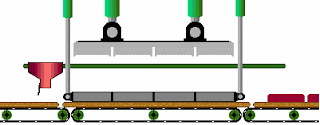Choosing Concrete Pavers
Interlocking concrete pavers, segmental pavers or simply
pavers come in a wide range of sizes, textures and colors. The days of one or two choices are gone. This can make choosing a new patio or walkway
extremely confusing. When looking at
displays at a distributor, take note of these subtle and not so subtle
differences:
1. Paver Type:
Dry Cast
Dry cast pavers are made with a very dry mix of gravel,
sand, cement and color. This mixture is
poured into paver molds then hydraulically pressed and vibrated in the
mold. Since there is very little water
in this dry mix, the molds can be immediately removed and re-used. The pavers will cure, but are already in
their finished state. By using a dry or
zero slump mix, dry cast pavers are quick and easy to produce by machines and
are extremely strong. Concrete mix
produced from a concrete truck will have a psi of 2000 lbs or more. Pavers produced using these hydraulic presses
can easily exceed 8,000 psi. After
pavers have been set, a vibratory plate compactor can be used for final paver
compaction.
Examples of dry cast pavers include Coventry I from EP
Henry, Hera from Techo Bloc and Munich from CST.
Wet cast pavers are produced using a wet concrete mix poured
into a mold. Since this wet mix cannot
be hydraulically pressed, wet cast material will need to set in the mold and
will have a weaker psi, typically 6,500 psi or less. The material must remain in the mold for a
few days meaning the molds cannot be used as often as dry cast materials. The wet cast process, while weaker and more
time consuming allows for bigger sizes and more interesting textures. The process to make wet cast pavers is
strong, but it is too weak to use a tamping machine on for final paver
compaction.
Examples of wet cast products include Devonstone from EP
Henry, Aberdeen from Techo Bloc and Blu Mountain Stone from Kennedy
Concrete/CST.
2. Size/Scale:
Traditional pavers generally include 4x8 Brickstone and 6x6
and 6x9 Old Town Cobble. Pavers now are
available in various sizes from 4”x8” Brickstone up to 30”x30” Monticello. Some pavers use one or two sizes for a
specific pattern while other pavers use five or more sizes to achieve more of a
natural “flagstone” look.
3. Texture:
The surface texture of pavers can include a completely
smooth surface (Village Square, Royale, Contempra), to a tumbled paver (Coventry, Hera, Munich)
or even a more natural look (Bristol, Blu 60, CST Slate Stone). Devonstone and Kennedy Blue Mountain are wet
cast pavers which very closely match the look of natural flagstone in texture,
color and size.
4. Pattern:
Pattern choices are almost as varied as paver choices. Patterns include a very simple one size
pattern such as running bond to two sizes such as an I pattern with Coventry 1
to a multi sized random pattern you can achieve with Brisol, Blu 60, Slate
Stone or natural flagstone.
5. Cost:
Generally, smaller smoother pavers such as Old Town Cobble,
Parisien or Roman Cobble are less expensive than tumbled pavers such as
Coventry 1 or Hera. Additionally, larger
scale and wet cast material such as Monticello or Aberdeen tend to be on the
more expensive side. Some good middle of
the road material includes Munich, Hera, Coventry 1, Blu 60, Slate Stone and
Bristol. While the cost of pavers can
vary greatly, the cost for the other components (2a base stone, sand, edge
restraint ect…) is pretty much the same no matter which material you choose.









some really great information on the different types of concrete pavers out there. Doing my homework and finding the best fit for my patio really paid off. I just love the way it came out
ReplyDeleteInnovative and unique concrete pavers are in demand. People do not want the same design of pavers in their parking. They like new patterns which can make their parking dissimilar from other houses parking.
ReplyDeleteConcrete Patio Toronto
Concrete pavers are best when they have no grass growing between them. Rock gardens, pebble, and other aggregate are great. Pavers with strips of lawn between them are hard to mow and edge, and they die more quickly when they are in a high foot traffic area. Getting a clear line between lawn and pavers keeps them cleaner, too. larryjacobconstruction.com
ReplyDeleteWe have a large range of different types of Artificial grass to meet your needs and budget. We have lush green grass, Tri colour (looks very real) and various colours. All our grass is uv resistant, flame retardant, waterproof, colourfast, pet and child friendly and all has a full manufacturers guarantee.
ReplyDeletePlease take a look at our shop and give us a call if you require and further advice.
Trade Artificial Grass , Cheap Artificial Grass , Artificial Grass Supliers , Artificial Grass Coventry , Artificial Grass Birmingham , Artificial Grass Nuneaton , Artificial Grass Warwick , Wholesale Artificial Grass
The curb becomes a permanent solution to separating his rock and flower beds. concrete pouring companies
ReplyDeleteWe are the leading manufactures of Rubber Moulds for wet cast paver production from India. We have client base at India and 28 countries global.We have a wide range of mould profiles to choose from , we can make customized moulds of your choice.Our rubber moulds are highly durable and can be used for production for many continuous years.We have moulds for pavers,tiles,kerbs,cover blocks/spacers.You may visit us at www.jrrubbermouds.com
ReplyDeleteRegards,Steffy Jose , +91 8589082225 , jrrubber@gmail.com
High-quality pavers Santa Barbara add charm, texture, and long-lasting beauty to driveways, patios, and walkways for any property.
ReplyDelete